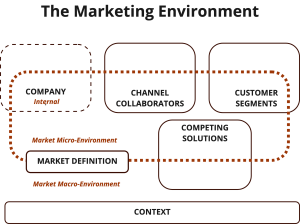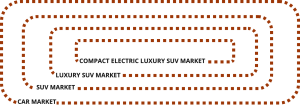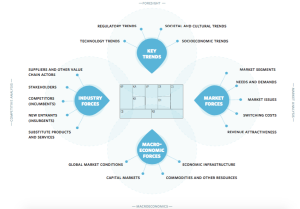Module 2: Assessing the Market Environment
2.1 Scanning your Market Environment: Frameworks and Concepts
Guiding Questions
- What is the purpose of scanning your market environment?
- In the 5Cs model of the market environment, can you explain aspects of the market environment covered by each “C”?
- What three levels of the environment are useful to scan? What defines the boundaries of each level?
- In the Business Model Environment framework, can you explain aspects covered by each of the four major elements?
- What are three types of competitive alternatives to look for in your scan?
The specific situation, or environment, in which an organization’s competes to build relationships with customers introduces important opportunities and threats. A marketing strategy that works well in one market, in one time and place, may completely fail in another. So regularly scanning your market environment is an important part of building market insight, finding marketing opportunities, and developing marketing strategy and plans. This chapter covers several conceptual models that are useful tools for organizing that scan.
The 5Cs Model of the Market Environment

Figure 1 shows the most commonly used model for scanning the marketing environment. This model includes five conceptual elements, known as the “5Cs”: Company, Customer Segments, Channel Collaborators, Competing Solutions, and Context.
- Company: specific organizational goals, resources and constraints relevant to our goals in this market
- Customer Segments: the sets of customers we choose to serve in this market, the needs we aim to address, and the habits and preferences they bring to their decision for addressing these needs.
- Channel Collaborators: the people and organizations we work with and through to connect with, serve and build relationships with our chosen customers
- Competing Solutions: the alternatives that customers consider as viable solutions to address their needs
- Context: societal, economic, legal, technological and natural factors that enable or constrain actions in the market
Levels of the Market Environment
These five elements are organized into two external environmental levels: the market micro-environment and market macro-environment. In addition, because an organization’s marketing strategy must integrate with the rest of the organization’s strategy, marketers also scan internally.
The Market Definition: The Dividing Line Between Micro- and Macro-Environments
Before beginning our scan, we define the scope of the environment that we want to consider by choosing our market definition. Throughout history people have build physical places– marketplaces– where buyers and sellers come together to exchange. Our market definitions abstract from that that physical metaphor to define the scope of buyers and sellers coming into contact with each other for specific purposes.[1]. Most commonly, markets are defined by the name of the category of product or service that is exchanged (for example, the “car market”). Markets can be defined at various levels of abstraction (for example, “the car market”, “the SUV market”, “the luxury SUV market”, “the compact electric luxury SUV market”).

In mature markets most buyers, sellers and others involved agree on market definitions. However as markets grow and evolve, new markets are defined and old ones redefined. This represents an opportunity and challenge for marketers, which will be discussed in the next module.
Our market definition becomes the dividing line between our micro- and macro- environments.
Market Micro-Environment: Customer Segments, Channel Collaborators, Competitive Alternatives
The micro-environment of a market is defined as the the interactions between the buyers (customer segments), sellers (competitive alternatives) and mediating agents (channel collaborators) involved in it. The goal in our scan of the micro-environment is to identify important players, and also assess the dynamics of their interactions. Questions we might ask during our scan might include: Who are important customer segments and competing organizations? How are they growing and changing? What form do relationships take between sellers and customer segments in this market? How intensely do competitors compete with one another? Who is particularly important to contract or partner with to reach and influence customers in this market? What is the role and relative power of channel collaborators? How have these market dynamics been changing over time, and how might they change in the future?
Market Macro-Environment: Context
In addition to taking into account the dynamics among themselves, all players in a market must consider factors and trends that are jointly affecting them all. We define these broad contextual factors as the market’s macro-environment. These include laws and regulations, overall macroeconomic conditions, technological innovation and social factors. All of these can change both buyers’ needs and preferences and enabling and constrain sellers’ abilities to make offers to meet them. When scanning the market macro-environment, our goal is again to identify important factors and trends relevant to competing to make desirable offers to customers in this particular market.
The Internal Environment: Company
The final level to scan are factors that come from inside our own organization. They include the organization’s overall mission and goals, as set by its overall strategy, our current position and goals in this market and others, and key aspects of our business model relevant to competing to create desirable value in this market. You’ll notice in the model above that not all of our organization is shown as “inside” this market. That is because there are often lots of important parts of our organization and its business model that are not focused on or relevant to competing in a particular market. Our goal in our internal scan is to identify the subset of all of the aspects of our organization that are particularly relevant goals, resources or constraints within this particular market
The Business Model Environment: A Second Tool
The 5Cs model is the most well-known tool for scanning the marketing environment. However, because understanding specifics about the situation you are facing is a key step in many domains, there are many tools for scanning environments. Not surprisingly, the developers of the business model canvas also recognized the need for managers to consider the environment in which organizations compete with their business models. So they developed a framework called the “business model environment”, that surrounds the business model canvas. Because the business model canvas is a tool for the organization’s overall strategy, including it’s marketing strategy, the scope of the environment around it is broader than the market environment that is the focus of the 5Cs model.[2] However it includes details that are useful for understanding the market environment more deeply.

The business model environment framework has four key categories: industry forces, market forces, macroeconomic forces and key trends:
- Industry forces: other entities that collaborate or compete with an organization, or are otherwise stakeholders in its success or failure
- Market forces: factors specifically related to the market or markets in which the organization competes
- Macro-economic forces: current contextual factors related to the broader economy in which the organization is embedded
- Key trends: potential changes in the macro-environment in which this organization is embedded.
Types of Competition
The industry forces category of the business model environment highlights three useful types of competitive alternatives that customers might consider as solutions to their needs: incumbents, insurgents and substitutes.
- Incumbents are organizations competing in the market with similar business models and similar offers. Incumbents are generally well-positioned to serve the largest customer segments in the market with their offers. In mature markets, most competition comes from incumbents, and most customers are served by them. So these are the competitors that come most quickly to mind when scanning the marketing environment. For example, in the new car market the major car manufacturers are all incumbents.
- Insurgents are organizations also competing in the market, but who enter with substantially different offers, often supported by substantially different business models. These offers are often not aligned with the needs of the largest customer segments. Instead, insurgents often enter a market by serving smaller segments or segments who don’t regularly purchase in the market. If they are successful they can capture the attention of the larger customer segments and disrupt the position of the incumbents. For example, Tesla entered the car market with their first electric car by targeting very high end customers with a car that couldn’t go very far before needing to be recharged.
- Substitutes are competing solutions that come from outside the market. Substitutes can include organizations that compete in other markets. For example, bicycle suppliers and ride share companies might be substitutes for some customers in the car market. Substitutes can include customers constructing their own solutions, ignoring needs, or changing their situations to reduce or eliminate them.
The importance of these three types of competitive alternatives varies by customer segment and over time. We will return and dig more deeply into competitive analysis as we build and position new and improved offers for specific segments.
Key Takeaways
- Regularly and systematically scanning the market environment is an important part of building market insight. That insight helps to find marketing opportunities and develop strategies and plans to pursue them.
- The 5Cs model of the market environment is a useful framework for organizing your scan. It includes your Company, Customer Segments, Channel Collaborators, Competing Solutions and Context, organized into the market micro-environment and macro-environment plus relevant internal factors.
- The chosen market definition sets the boundary between the market micro- and macro- environments. In mature markets, product or service categories are usually used as market definitions.
- The business model environment is an alternative framework designed to scan the environment for constraints, threats and opportunities affecting an entire business model. It includes four broad elements: industry forces, market forces, macroeconomic factors and key trends. These cover similar, but broader, ground as the 5Cs model.
- Identification of three types of potential competing solutions that customers might consider is an important part of a market environment scan. These three types are incumbents, insurgents and substitutes. The importance of each varies by particular customer segments and as the market evolves over time.
- Britannica.com ↵
- For more about using the business model environment tool for organization strategy, see https://www.strategyzer.com/blog/posts/2015/10/14/how-to-scan-through-your-environments-disruptive-threats-and-opportunities. ↵